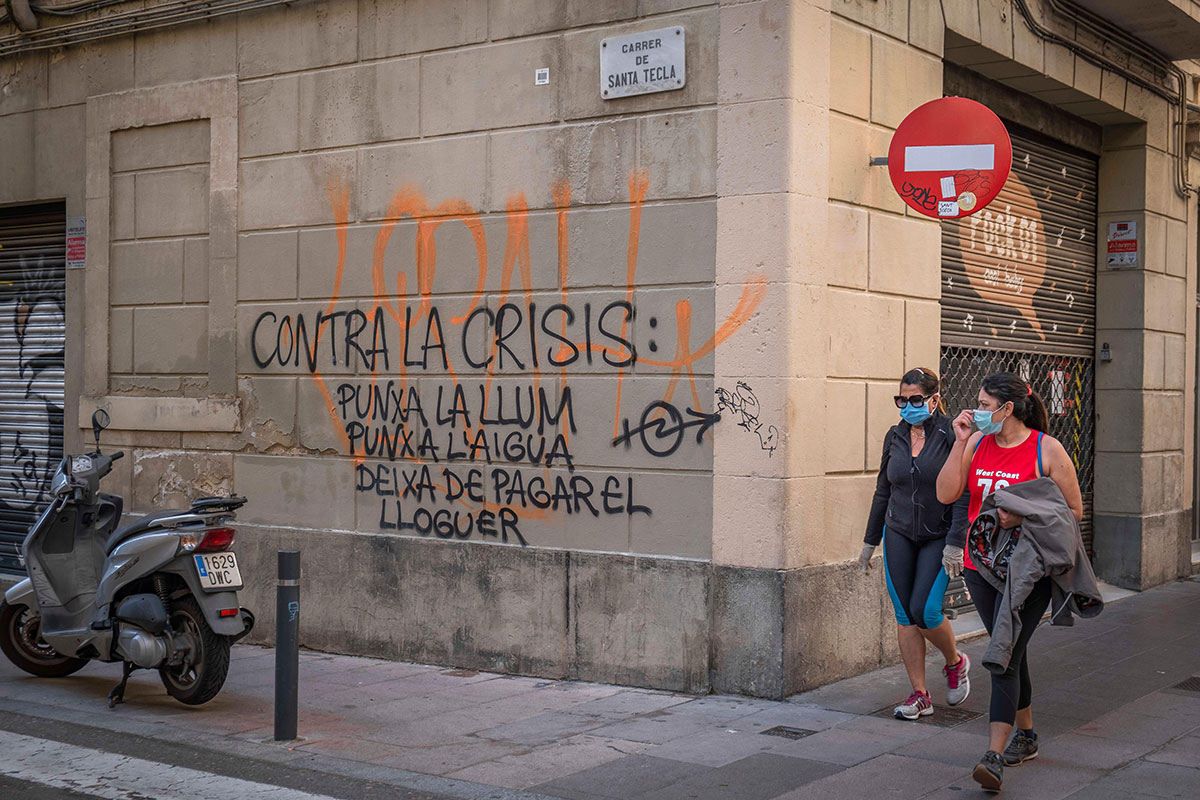How Europe’s housing sector has responded to the COVID-19 crisis
As Europe begins to emerge from lockdown, Jack Simpson finds out how different countries’ housing sectors have dealt with the pandemic. Pictures by Getty and Alamy
It was 11 February when Adriano Trevisan was admitted to hospital in Padua, northern Italy. The 78-year-old from the small town of Vo in Veneto had entered with no coronavirus symptoms. By 21 February, Mr Trevisan was dead, becoming Italy’s first official victim of COVID-19.
On the day of Mr Trevisan’s death, Italian health authorities announced 15 new cases throughout the Lombardy region. They were the first known cases of local transmission in the country. Coronavirus had taken hold of the southern European nation.
“Eviction bans, mortgage moratoriums or unprecedented welfare giveaways – housing has been at the forefront of the response and will likely be key to Europe’s recovery”
Spain was next, with thousands dying in a matter of days, and by early March, the virus had spread to every corner of Europe.
Eighty-four days on from that first death in Italy, 1.7 million have been infected by COVID-19 in Europe, and 163,000 have been killed by the disease.
The health crisis is the worst Europe has seen since the Spanish flu outbreak in 1918, and the economic tremors will be felt for years to come.
No sector is immune, including housing.
As fears of job losses and financial hardship grow, housing – and how to ensure people are housed – has become a key part of government responses.
Whether that is in the form of eviction bans, mortgage moratoriums or unprecedented welfare giveaways, housing has been at the forefront of the response and will likely be key to Europe’s recovery.
As the continent takes its first tentative steps out of lockdown, Inside Housing asks what the UK can learn from other countries.
Here, we compare how different European countries have responded, and how culture, politics and housing structures have influenced the similarities and differences in policy.
Italy
Piazza del Duomo in Milan during the Italian capital’s coronavirus lockdown
Population: 60.5 million. COVID-19 cases/deaths: 226,000/32,007. Homeownership: 72.4%. Rented (market and social): 27.6%
When the virus spread through northern Italy in early March, the rest of Europe watched in horror as the number of deaths climbed. The first European country to go into full lockdown, it provided the continent with a glimpse of what its future could be like.
That lockdown has been strict, with most confined to their apartments for 60 days, able to leave their homes only to buy food or medication.
“There’s been quite a big debate about the standard of housing in Italy because people have had to spend so much time in their apartments,” says Martina Gentili, an academic in the built environment department at Delft University of Technology in the Netherlands.
She says this has filtered into the thinking of developers, with some mulling over how quality and space can be improved.
“The housing market is much less financialised compared to Britain and Northern Europe because of these family apartments”
As the first European country to be ravaged by the disease, Italy was the test bed for many housing policies deployed across Europe. And as a country with 72% homeownership, mortgages were tackled early.
“One of the first measures enacted was opening the possibility of negotiating to suspend temporarily the payment of mortgages,” says Giovanni Semi, associate professor of sociology at the University of Turin.
But the need for mortgage support is a bigger issue in other nations than it is in Italy, because of the country’s culture of homes being passed through the family.
“The housing market is much less financialised [compared] to Britain and Northern Europe because of these family apartments,” Mr Semi explains.
While in many countries, the focus has been on how to protect the renter, in Italy the landlord’s voice is louder.
“Groups representing renters are quite weak, politically speaking,” Mr Semi explains. “There is no public debate on tenant conditions – the public debate is on how to protect landlords’ income.
This is true for landlords who have tenants but especially for those who rely on Airbnb and similar platforms.
This focus on homeowners can be seen in the housing subsidies being given. A fund to help first-time homeowners to pay their mortgage has been bolstered, and the number of people able to access it has been expanded.
Ms Gentili explains that an evictions ban is the only piece of national legislation brought in to protect private renters. It will now last until September as the government was persuaded to extend its initial July deadline. However, an avalanche of evictions could follow when the ban is lifted. “This is a huge fear,” Ms Gentili says.
For the more than 50,000 people on the streets, the situation is tough.
“The Catholic church is doing a lot for these people, but it’s mostly down to volunteer work. There’s no central funding going towards housing rough sleepers,” Ms Gentili explains.
She says that in some cases rough sleepers were fined by police for not obeying the lockdown, despite having nowhere to go.
Spain
Graffiti against the housing crisis
Population: 46.8 million. COVID-19 cases/deaths: 232,000/27,709. Homeownership: 76.3%. Rented (market and social): 23.7%
Spain was the second European nation to show how fast the pandemic could spread. Its 1,982 deaths across two days in early April established Europe as the new global epicentre of the pandemic.
It has the fourth-highest number of deaths per population globally – behind Andorra, Belgium and San Marino – with 584 deaths per million people. The country, currently governed by a left-wing coalition, has had some of the most generous policies for protecting tenants and homeowners.
Spain has one of the highest homeownership rates in Europe and 40% of homeowners do not have a mortgage. For people with a mortgage, a moratorium on payments and protections against possession have been put in place for those who can prove they have been impacted by the virus.
But Sergio Nasarre-Aznar, civil law professor at the University Rovira i Virgili and director of the UNESCO Housing Chair, says that while this will protect homeowners in the short term, he foresees issues further down the road.
“Banks are seeing a peak in defaults on mortgages and they foresee a situation where it is going to be much more complicated in the coming months,” he says.
El Pais, Spain’s largest newspaper, also reported that only one in 10 homeowners was able to satisfy the criteria to access the mortgage protection.
For private renters, tenancy agreements set to end during the crisis were automatically extended until six months after the country’s state of emergency ends. This is expected to happen in June. A ban on evictions is in place for the same period. Rents have been frozen, and in some cases reduced.
Landlords with 10 or more properties must reduce rents by as much as 50% during the state of emergency, and up to four months after it ends, or alternatively agree to a rent payment plan that can be paid up to three years after the crisis. Renters can also access bank loans guaranteed by the government to help them cover rents, with a payback term of up to 10 years.
With social housing nearly non-existent – at around 2% – and renting cheaper than buying in all but two regions of Spain, it has a homeless population of between 30,000 and 40,000 people.
Like in other countries, a mass effort was carried out to house them, including using basketball arenas.
“I support this move, but it’s just a shame a virus had to come so that these people could be housed,” Mr Nasarre-Aznar says.
France
France has aimed to house its homeless population
Population: 65.3 million. COVID-19 cases/deaths: 179,927/28,239. Homeownership: 65.1%. Rented (market and social): 34.9%
In 2014, France introduced a ‘winter truce’ on evictions. Between 1 November and 31 March every year since, tenant evictions have been prohibited to stop people from ending up on the streets because of unpaid rent.
When the country went into lockdown, the winter truce became the ‘COVID truce’, with the prohibition extended until July.
And with nine months of pent-up arrears, which have been supercharged by the COVID-19 crisis, there is a fear that the wave of evictions in July could be large.
In the social housing sector, the Social Union for Housing (USH), the body that represents France’s social housing providers, and tenant associations signed a unilateral agreement to protect social housing tenants. It stated that as a result of the crisis nobody would be evicted and landlords would devise payment plans for struggling tenants.
Similarly to the UK, private non-profit providers and local authorities are the two major managers and developers of social housing in France.
And there is an expectation of huge losses for these providers from unpaid rent.
“There are fears they will lose a lot of money because of the reduction in rent,” Carine Puyol, policy manager for EU affairs at the USH, explains.
Early indications are that the figure could be in the tens of millions of euros.
A number of additional welfare measures have been put in place to help those in need. An ‘exceptional aid fund’ was set up for the poorest in society, with families paid €150 on 15 May, and an extra €100 per child. An extra €350m was added to the ‘solidarity fund for housing’, to go to those in need.
The government also decided to halt planned reforms to the APL housing benefit, France’s main source of housing support, which would change the way people are deemed eligible for housing subsidy. The reform would mean a person’s eligibility would be based on their income in the previous year, rather than two years before. It is estimated that 600,000 people would lose their benefit, while 1.2 million would experience a decrease.
Winter truce accommodation, used to house 14,000 rough sleepers during winter months, was extended to May, and homelessness self-isolation centres were set up across the country.
The next big date the French housing sector is looking out for is when president Emmanuel Macron publishes his COVID-19 recovery plan. The social housing sector wants to feature prominently.
In 2008, similarly to Gordon Brown’s Labour government, which pumped funds into social housing to keep Britain building, social housing investment as a stimulus for the construction sector also made up a part of Nicolas Sarkozy’s recovery plan.
“The social housing sector hopes to be in the heart of this recovery plan,” Ms Puyol says.
“We will continue to rent to people, to build new developments and continue our work – we just need the money.”
Poland
A couple pose for a picture in Wroclaw
Population: 37.8 million. COVID-19 cases/deaths: 18,885/936. Homeownership: 84%. Rented (market and social): 16%
Poland responded to the virus quickly. Its first case was on 4 March. By 10 March, it had closed schools. By 17 March its borders had closed and by 25 March non-essential travel was prohibited.
It has also banned evictions, but this does not remove the tenant’s financial obligations and private landlords may be able to seize bank accounts if people do not pay their rent.
As of 2018, 84% of homes were under homeownership. A very small percentage of social housing is publicly owned and this is usually reserved for people with the lowest incomes.
Almost 675,000 of the four million Poles who have mortgages have secured mortgage holidays. But there is no decree by law for these to be in place and most have come through agreements with the banks.
Much of the Polish government’s assistance has been channelled through welfare support for workers, but there could also be some increases in housing subsidy for the poorest in society.
The government is currently considering a new law which will increase housing benefit significantly. This could move housing subsidy from the current average level of 220PLN (£43) to around 1,500PLN (£290), and could last for six months.
Romain Su, a French journalist working in Poland, explains: “The housing subsidy would be more significant for people, but it will benefit a tiny share of households – around 250,000.”
He believes that housing is not high up on the political agenda.
“In my opinion the actions of the government in terms of housing isn’t much debated, I think this is largely because Poles have been able to rely on themselves in this area,” he says.
Denmark
Population: 5.8m. Cases/deaths: 10,968/548. Homeownership: 60.5%. Rented (market and social): 34.9%
Denmark’s management of the outbreak has been praised by many. It was the second European country to announce a full lockdown and has so far recorded less than 600 deaths.
“We are worried that as more people lose their job or see their income drop, more places will be deemed ‘hard ghettoes’”
The Danish private rented sector is one of the most regulated in Europe, and rents are generally low, which has limited the impact of the virus on tenants. “I don’t think the tenants have a major problem with the COVID-19 crisis,” says Curt Liliegreen, project director at the Knowledge Centre for Housing Economics. “The crisis will be felt in other parts of the market.”
Danish mortgages are already extremely low, with some 30-year fixed-rate mortgages being obtained at interest rates as low as 0.5% and 1%. But Mr Liliegreen believes that low interest rates will not be enough for homeowners and that the banks will have to help out in order to avoid foreclosures.
In 2018, the former government with broad support enacted a law on ‘hard ghettoes’. These are defined as areas with more than 1,000 inhabitants, of whom 40% are unemployed, 50% were born outside Denmark, and 50% have a basic school education at the most or earn an average income 55% lower than the area’s average.
The law said these areas could be converted into other types of housing, demolished, or sold to private landlords in a bid to regenerate. The plan was to reduce the number of ‘hard ghettoes’ by 2030.
“We are worried that as more people lose their job or see their income drop, more places will be deemed ‘hard ghettoes’, and one of the consequences because of this law may be that we have to demolish or sell 60% of units in these areas,” explains Natalia Rogaczewska, director of public affairs at Danmarks Almene Boliger, which represents 500 housing organisations.
The Danish social housing model sees part of tenants’ rents go into a national renovation fund, with housing organisations applying to the fund to carry out refurbishment and regeneration schemes. There are currently 453 projects in waiting and prioritising these schemes is seen as potential stimulus to the construction sector post-coronavirus. After much lobbying from the social housing sector, the government last week approved a €4bn fund for those 453 projects – 72,000 homes – to be accelerated.
Ireland
Population: 4.9 million. COVID-19 cases/deaths: 24,200/1,547. Homeownership: 70.3%. Rented (market and social): 29.7%
Walk down Dublin’s Parnell Square on 17 March in any other year, and you would usually be greeted by thousands celebrating St Patrick’s Day. But this year Dublin’s city centre was eerily quiet.
A week later and Ireland was in full coronavirus lockdown. People over 70 were not allowed out, and those under 70 could only go 2km from their homes.
Significantly for the housing sector, construction sites were shut. This lasted for more than a month. They have only recently been opened, with social housing sites close to completion and deemed “urgent” opening first. Others have now followed.
“People’s rents will just fall if they lose their jobs”
This has had a major impact on a country with housing supply issues.
“We had an extremely large bust in the housebuilding sector in the 2008 financial crisis when output dropped by 80%,” says Michelle Norris, professor of social policy at University College Dublin.
“We still have a significant under-supply problem and there are concerns reopening sites will be difficult.”
There are currently talks ongoing in government about a stimulus package for the housebuilding sector through social housing investment. And this is needed in a country where homelessness is on the rise. Skyrocketing rents have meant that Ireland’s housing allowances cannot cover housing costs for many.
Emergency accommodation use has risen by 150% in the past five years.
To stop more people becoming homeless as a result of COVID-19, the government has frozen rents and banned evictions in the private rented sector for three months.
In social housing, where rents are linked to income, there is little fear of evictions.
“People’s rents will just fall if they lose their jobs,” Ms Norris explains.
To accommodate those on the streets, hotels have been block-booked and a large amount of Airbnb accommodation, unused during lockdown, has been leased by government-commissioned organisations.
Germany
Empty streets in Berlin during lockdown
Population: 83.8 million. COVID-19 cases/deaths: 177,289/8,123. Homeownership: 51.5%. Rented (market and social): 48.5%
Germany is a nation of tenants. With nearly 49% of its homes rented, it has the second-highest percentage of renters in Europe, behind only Switzerland.
As a result of this, much of its response to the COVID-19 crisis has been to protect renters. It comes from a position where strong protections are already in place.
“In general, German renters are really secure. You have permanent contracts which are very difficult to terminate other than for rent arrears.
“In many cases we have people renting one property for 20 to 30 years,” explains professor Michael Voigtlander, head of financial markets and real estate at the German Economic Institute in Cologne.
These protections come alongside a generous system of housing subsidy for low earners, while those with no income can have their rent fully paid by the state, with some restrictions on property size.
The protection and subsidy available to renters has been increased during the COVID-19 crisis.
An evictions ban has been brought in for renters who can prove that their income has been hit by the crisis.
“Unlike other countries where people have to show their income has dropped by 25% or 30%, in German law there is not that precision and I think the impact on income can be lower,” says Konstantin Kholodilin, research associate at DIW Berlin.
They are expected to pay the rent back over a two-year period, often with an interest rate of around 4%.
“[Landlords] have problems now that renters can postpone payments for two years. Many people are worried”
The amount of housing subsidy available to renters has been increased and the limit for those who can receive support lifted, in a bid to help those who have suddenly found themselves unable to work.
This support has so far meant that the country’s largest landlords have not seen huge drops in income. Germany’s largest landlord, Vonovia, said it had so far seen a 1% drop in rental income. A survey by GdW, the trade body that represents 3,000 landlords, found that in April its members had seen less than 1% of their properties unable to pay rent.
“This is just April, though,” says Ozgur Oner, director of the Brussels office at the GdW Federal Association of German Housing and Real Estate Companies. “May will be important for us.” Three-quarters of those surveyed expected higher rental losses in the coming months.
Mr Oner adds that the crisis has also meant 20% of its members have decreased their refurbishment investment as a result of social distancing rules preventing workers from entering properties.
A third of the country’s housing stock is owned by small private landlords and there are concerns for those who rely on this income.
“In Germany, we have a mix of large corporate landlords but also those on lower incomes – that can be those that inherit homes, are self-employed or have apartments as pension security,” Mr Voigtlander explains.
“These people have problems now that renters can postpone payments for two years. Many people are worried.”
Netherlands
Population: 17.3 million. COVID-19 cases/deaths: 44,141/5,964. Homeownership: 68.9%. Rented (market and social): 31.1%
With nearly a third of its housing stock owned by housing associations, the Netherlands has the largest percentage of social housing in Europe.
Social housing is run solely by associations that operate like those in the UK – private, non-profit organisations that provide affordable housing.
And as it has for UK housing associations, COVID-19 has posed many challenges for Dutch providers.
Along with private landlords, social landlords in the Netherlands moved quickly to declare that no tenant would be evicted during the crisis. Tenancy agreements that ended during the crisis were automatically extended by six months. Several housing providers also decided against their yearly July rent increases.
For social housing tenants there was no fear of eviction, thanks to a mechanism that was put in place before the crisis.
“There is a cry for the central government to take a role in planning and housing”
“We have a social rent agreement with the tenant organisations,” explains Robin van Leijen, European public affairs officer at Aedes, the Dutch representative group for housing associations.
“If you as a tenant feel like you cannot pay the rent, you may approach your social housing provider and they can lower your rent. Apart from that, social housing providers can offer a payment agreement.”
The agreement is now being used widely across the sector.
Housing subsidies have not been increased, but the welfare system around housing is more generous than in the UK. A furloughing scheme under which employees are paid 90% of their wages and are allowed to continue working is also in place.
There are fears that Holland’s housing crisis could worsen, with commercial development hampered by an economic downturn. Many believe that support for the social housing sector could negate this.
“A big lesson from the 2008 crash was that associations should continue to build during a recession to prevent a loss of construction capacity. We believe we can be an engine because we are not affected by market conditions and we can continue to build,” Mr van Leijen says.
Dutch associations do not receive government grant. Their incomes are instead reliant mainly on rent and some state-guaranteed borrowing. They are also faced with high corporation taxes and a costly landlord levy targeted only at housing associations. In some cases, this levy can be equal to a quarter of an association’s yearly rental income.
There is pressure for these to be abolished to support a social housebuilding renaissance.
Last week the government issued a €1bn tax cut for associations in return for the construction of new homes. Lobbyists are now pushing for the repeal of the levy.
Mortgage holidays have been offered to homeowners under the conditions that recipients prove their income has been hit and they are at risk of repossession.
While the sales market has reduced and social distancing was applied to moves, it was not to the same extent of the UK housing market freeze.
“Online valuations and virtual visits are increasing rapidly, there is a huge shortage [of homes to buy] so many young people are seeing this as an opportunity,” says Marja Elsinga, professor of housing institutions and governance in the faculty of architecture and built environment at Delft University of Technology,
But Ms Elsinga believes one of the biggest shifts is how the crisis has forced housing up the political agenda.
“There is hardly any national housing policy, but now during the crisis there is a cry for the central government to take a role in planning and housing,” she says.
“The crisis makes it more urgent – things have changed.”
More on coronavirus
To see all our coronavirus coverage to date – including the latest news, advice to providers, comment and analysis – use the link below.
Sign up for our daily newsletter
Already have an account? Click here to manage your newsletters



















